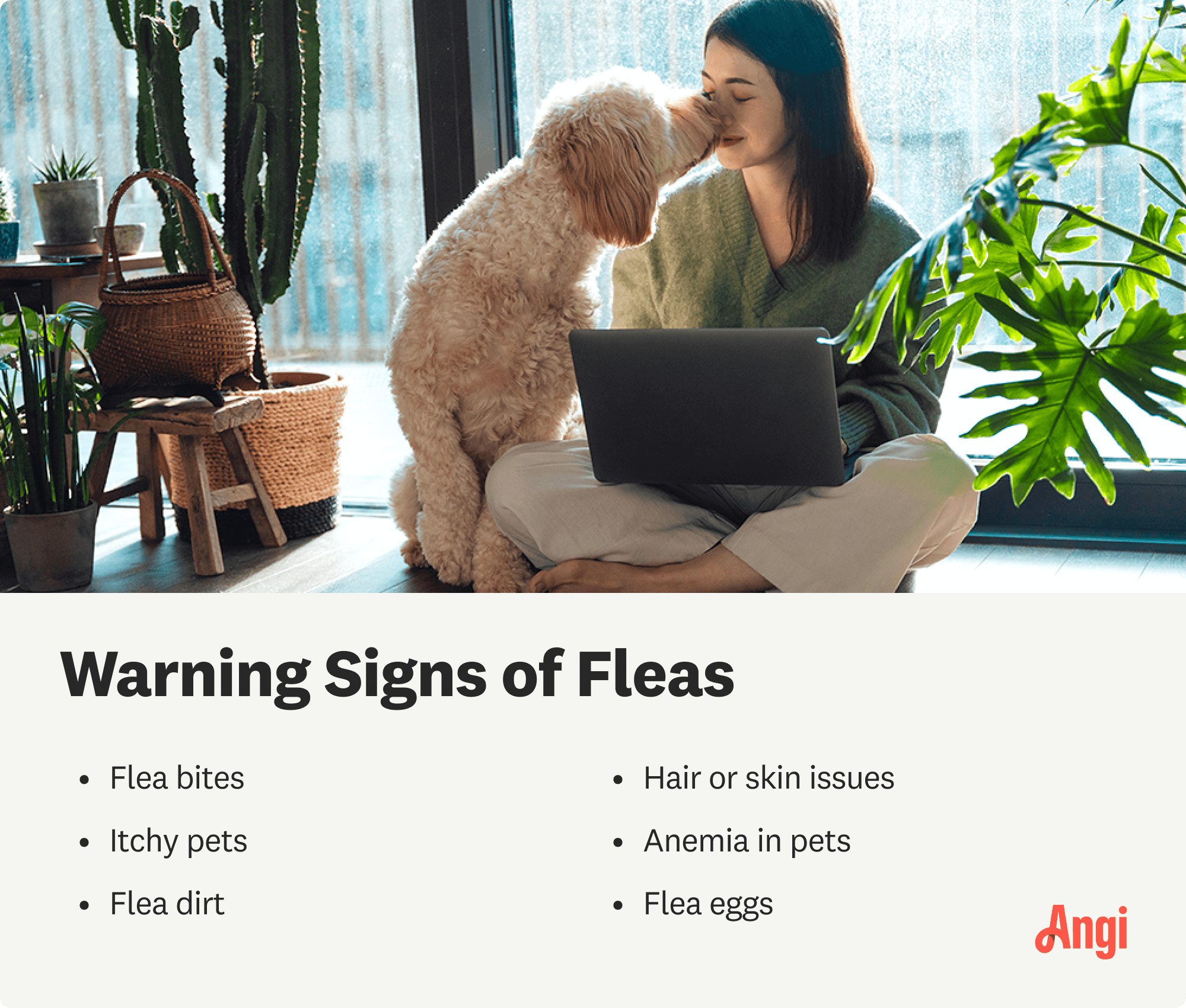
Whether you have bugs, bats, or rodents invading your home, you’ll want to contact an exterminator quickly. Find out how much pest control costs in Columbus, OH.
Make traps from scratch to end the scratching


While you can make a DIY flea trap for no more than $20, a flea exterminator costs between $75 and $400 and can complete the project faster and safer.
DIY methods may not be effective for major flea infestations. If you have a major flea infestation rather than a minor issue, you will need to reach out to your local pest control specialist.
Flea exterminators have access to professional-grade insecticides and treatment plans that target fleas at every stage of their life cycle.
Homeowners often underestimate the extent of an infestation or miss key hiding spots, which can lead to recurring problems without expert help.
Homemade flea traps, especially those using heat or light sources, can be dangerous if knocked over by children or pets.
If you’re looking for natural ways to kill fleas, you’ve come to the right place. These small but mighty insects can become a nuisance and potentially spread harmful diseases if not treated properly. Make a DIY flea trap from household ingredients to rid your home of these itchy pests.
Fleas find their way into many homes for a number of reasons, and it’s often not your fault.
Here are the main ways fleas get into your house:
On pets and stray animals
From wildlife, like raccoons and squirrels, that come to your yard
Humans who have been in infested environments
Through cracks in the floor and holes in your window screens
Gaps around your doors and windows
On used furniture, clothing, and linens
Different things can attract fleas to your home, including an overgrown lawn, clutter, warmth, and light.

Look for signs of fleas if you suspect them on your pet or in your home. Catching them earlier rather than later can save a lot of strife and expense.
Here are some defining features of fleas and signs that they may be in your home:
Tiny (1/8-inch long) oval, reddish-brown or black bugs
Flat bodies
Wingless bugs with six legs, including large hind legs for jumping
Itching and irritation in your pets, you, or your family members
Small, dark specks that resemble pepper (flea feces) on carpet, bedding, and pet areas
Pale gums in your pets
Use a flea comb with fine teeth to look through your pet’s fur, or walk around your home with white socks to spot fleas that jump on you. If you don’t have pets but are still dealing with tiny pests, you might actually have bed bugs.
You can make three types of DIY flea traps with household ingredients, including dish soap, corn syrup, or double-sided tape. Set up traps in areas where you’ve spotted fleas, such as near where your pet sleeps or spends the most time. Fleas hide in spaces like pet beds, pet bowls, near linens, upholstered furniture, or carpeting.

The best homemade flea trap is a mixture of dish soap and water in a shallow dish. The soap makes the bugs sink to the bottom. Lay a towel under your trap, and place the trap in an area where you’ve noticed fleas.
Pour water into a shallow dish.
Add 1 to 2 tablespoons of liquid dish soap and mix it in with a spoon.
Consider adding Alka-Seltzer to make the trap even more effective.
Add a nearby light source, such as a desk lamp, and leave all other lights off.
Leave the trap overnight (the rest of the room should be dark except your light). Make sure no pets or children are in the space—electricity and water pose a significant safety risk should the trap or light get bumped.
Pour out the mixture and reset for the following night.

Fleas stick to the corn syrup as they jump toward the light in this DIY trap. Make the trap in a shallow dish, such as a pie plate or cookie sheet with edges.
Mix equal parts corn syrup and water and bring it to a boil in a pot.
Turn off the heat and let the mixture cool completely.
Pour the mixture into a shallow dish.
Turn on a desk lamp above the flea trap and leave all other lights off.
Let the trap sit overnight. Make sure no pets or children are in the space.
Clear the trap in the morning and reset it for the next night.

Create a sticky pad with a light to attract the fleas and catch them when they jump.
Cover a piece of cardboard with double-sided tape.
Turn on a desk lamp near the trap, but leave all other lights off.
Leave the trap to sit overnight.
Refresh the trap when it gets too full of fleas.
The life cycle of a flea is long, up to 100 days. If you don’t get rid of fleas as soon as you notice them, you risk further infestation and complications for you, your home, and your pets.
Here are the main risks of not addressing fleas:
Harder to eliminate, especially if they’ve laid eggs
Severe skin issues and itching for you and your pet
Constant scratching and skin breaking, increasing the risk of impetigo and cellulitis
Pet hair loss
Allergic reactions, such as hives or rashes
Disease transmission, such as flea-borne typhus and bartonellosis
Anemia in pets due to significant blood loss
Financial strain
Psychological stress
Full home infestation in bedding, furniture, and carpets
Here are the best ways to prevent fleas:
Regularly check your dogs or cats for fleas.
Bathe your pets weekly to keep fleas at bay.
Vacuum and sweep your home regularly.
Clean window sills, vents, and gaps in your windows and doors.
Deep clean your pet’s favorite areas and their bedding.
Clean furniture regularly with wood or upholstery cleaner.
Regularly wash sheets and bedding on a hot setting.
Sprinkle baking soda near the base of your furniture.
Keep your yard well-maintained and remove clutter, debris, and lawn waste.
Limit contact with stray animals and wildlife.
Clean floors and baseboards regularly.
Consult your veterinarian about using flea collars or topical treatments.
A DIY flea trap can cost next to nothing if you have the tools and materials on hand. If you have to purchase a few items for the trap, you likely won’t have to spend more than $20 total.
This DIY cost is a far cry from flea exterminator costs, which can range from $75 to $400. However, a flea trap is best used for a small problem and not a major infestation, which would require the help of your local pest control specialist.
Our office has a new lease on life, thanks to Custom Paint Jobs LLC. Outstanding work!
Window Depot did an amazing job on my deck. I wasnt sure what I wanted to do, but their composite decking was affordable and will last a long time. I am excited to have family over, and I am no longer embarrassed by my backyard. Jeff and the ground crew were polite, respectful, and caring for...
AFS was excellent from start to finish. Jess, the sales associate, was fantastic...very knowledgeable and very professional. The installation crew was excellent. I couldn't be more pleased with the process. Best of all, my new floor looks fantastic!
We used Unique Hardwood Floor LLC three years ago to work on the floors of a 70 year old home that needed a great deal of work. Some floors needed repairs, some were replaced and others just needed to be refinished. It was a complicated job as they needed to blend the old and the new to...
While Naaman and Mike were very professional and amicable to work with, there were issues in this project that makes giving a higher rating impossible. We had several communications issues that delayed completion. The roofers accessed the property without communicating with me. Just showed up...
They called 15 minutes before arrival to announce that they were coming and arrived on time. Immediately they saw the broken springs and replaced them very quickly. Jeff suggest that I put on a rope to the manual switch to operate it more easily if necessary. I explained that my old door...
From average costs to expert advice, get all the answers you need to get your job done.

Whether you have bugs, bats, or rodents invading your home, you’ll want to contact an exterminator quickly. Find out how much pest control costs in Columbus, OH.

When calculating the cost of hiring a flea exterminator, consider your home size and the infestation extent. This guide will help you figure out what to budget.

Keep your home free of termites and the damage they do. Learn more about inspections, infestations, and the average cost of termite treatments.

If your dog brought some unwelcome pests into bed with you, learn how to get rid of fleas in bed before you’re covered in itchy bites.

Discover methods for how to get rid of rabbits using humane tactics, including fences, repellents, and a decoy garden. Get ready to send those bunnies hopping.

Nobody wants to tangle with wasps on their property, as these insects sting with extreme prejudice. Here’s how to get rid of wasps safely and for good.